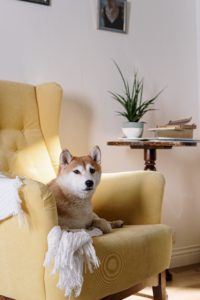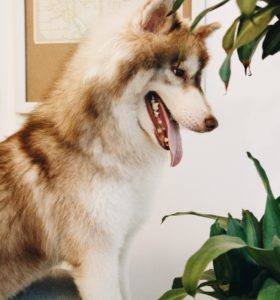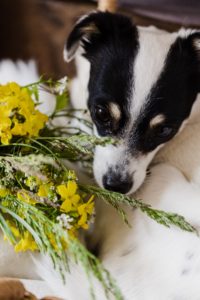Many of us like to decorate our homes with beautiful or exotic flora that bring a little of the outside in and make us feel comfy and cozy in our space. And while there’s nothing wrong with caring for these handy houseplants, there are several species of domestic plants that can be dangerous to our dogs. As responsible pet parents, it’s important to note which houseplants are safe for our furry friends and which can lead to disaster. If you have any of the following plants in your home, take extra caution when your precious pup is around them.
 1. Peace Lily
1. Peace Lily
This popular houseplant is known for it’s large size, beautiful snow-white flowers, and dark, glossy leaves. Many people enjoy peace lilies because they bloom often and are easy to care for. They are, however, unfortunately toxic to both dogs and cats. When chewed on or ingested, the peace lily can cause irritation to the mouth, lips and tongue, increased salivation, vomiting, difficulty swallowing or, in some cases, difficulty breathing. It’s best to keep this hardy houseplant away from your pets at all times.
2. Aloe Vera
This nifty succulent has many positive medicinal purposes for us humans, including helping to heal burns and other mild skin irritants. Because of its many uses, aloe makes a stand as a very popular houseplant to keep around. But while aloe is harmless to us humans, it can be devastating to dogs if ingested. Signs of aloe poising in dogs includes lethargy, vomiting, diarrhea, and urinary problems. Keeping aloe vera up on shelves and away from curious pups could help keep them safe!
3. Fiddle Leaf Fig
Fiddle leaf fig is a very distinctive and beautiful plant which can be easily recognized by its very large, violin-shaped leaves. These plants became popular after appearing in many magazines and articles of house design and decorating, adding a simple but elegant look to a living space or room corner. They are also, unfortunately, quite toxic to cats and dogs. If ingested, fiddle leaf fig can cause upset stomach and vomiting at best, to excessive thirst and kidney failure at worst. They might be beautiful, but it’s probably best to keep this plant out of your dog-friendly home.
4. Bird of Paradise
Known for its brilliantly colored flowers that resemble birds taking flight, bird of paradise is an elegant and highly attractive plant that many like to keep in their homes. Ironically, however, the bird-like flower of this plant is also the most toxic to dogs. Symptoms of toxicity from this plant include upset stomach, vomiting, increased heart rate and, in some cases, muscle tremors and incoordination. If you know your pup’s curiosity gets the better of him sometimes, you might want to keep this pretty plant out of your home.
 5. English Ivy
5. English Ivy
This popular type of ivy can be found in many households due to its beautiful star-like leaves and propensity to trail, climb walls, and wrap around objects. It does look rather elegant in a home and might make you feel like you’re living in a quaint English cottage, but this ivy can be dangerous for dogs. If chewed or swallowed, ivy can cause mouth and stomach irritation, excessive drooling or panting, foaming at the mouth, vomiting and, in extreme cases, swelling of the tongue and throat. If you like plants that trail, perhaps looking into a different variety would be best.
6. Philodendron
There are many varieties of philodendron, but all tend to be low maintenance and easy to care for. With some of the more common plants growing up to 8 feet and having large, waxy, palm-like leaves, it’s no wonder these exotic beauties became so popular. Unfortunately, philodendrons are also toxic to most pets, including dogs. Symptoms of toxicity include burning and swelling of the mouth and tongue, vomiting, diarrhea, difficulty swallowing or breathing and, in some cases, cardiac arrest. Be very mindful in choosing a philodendron for your home.
7. Begonia
Like philodendrons, there are many varieties of begonias that come in an array of shapes and colors. They can be indoor or outdoor plants, and are popular for the fact that they never stop blooming. While not as bad as other plants on this list, begonias can still cause irritation of the mouth, tongue and throat if ingested by dogs. The most toxic part of the plant tends to be underground in the roots and, if eaten in excess, can cause trouble swallowing or breathing. Always monitor pets closely around this pretty plant.
8. Alocasia
Despite its temperamental ways and specific maintenance, alocasia remains a popular houseplant due to its beautiful and unique leaf shape, which resembles a long, pointed arrowhead. Unfortunately, alocasia is also unique in that it contains calcium oxalate crystals, which is toxic to dogs, cats and humans. If chewed, the plant will release the crystals which causes penetration of the mouth and tongue, and irritation in the GI tract which can cause vomiting and inflammation. In severe cases, alocasia poisoning can cause a slow heart rate and lack of coordination. Maybe it’s best to avoid this plant all together.
 9. Jade
9. Jade
With oval-shaped leaves and woody stems, jade plants resemble tiny trees that don’t require a lot of care or attention. Because jade can also live for up to 100 years, they remain popular in households and add a rather beautiful aesthetic to a room. Sadly, these ancient plants are also very toxic to dogs. If eaten, jade can cause gastric distress and vomiting, irregular heartbeat, diarrhea, depression, and incoordination. Keep jade plants up and away from your animals to avoid a stressful situation!
10. Eucalyptus
Fresh and dried eucalyptus is very popular right now as a houseplant for its delicate look and pale, green coloring. The plant also has many medicinal properties for us humans and can be found in oils, perfumes, cosmetics, and personal care products. Unfortunately for our canine friends, the plant has the opposite effect on them. If ingested, eucalyptus can cause excessive drooling, confusion, vomiting and, in severe cases, rapid or shallow breathing followed by slow reflexes and confusion. If using eucalyptus to decorate your home, consider hanging it somewhere high and out of reach.